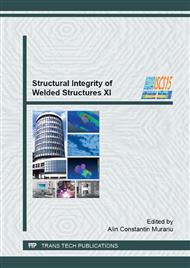[1]
Lippiatt, B.C., Ahmad, S. Measuring the life-cycle environmental and economic performance of concrete: the BEES approach. In: Proceedings of the International Workshop on Sustainable Development and Concrete Technology, 2004, pp.213-230.
Google Scholar
[2]
Knudsen, A., Jensen, F. M., Klinghoffer, O., & Skovsgaard, T. Cost-effective enhancement of durability of concrete structures by intelligent use of stainless steel reinforcement. In: Conference on Corrosion and rehabilitation of reinforced concrete structures, Florida, (1998).
Google Scholar
[3]
Koch, G. H., Brongers, M. P., Thompson, N. G., Virmani, Y. P., & Payer, J. H. (2002). Corrosion cost and preventive strategies in the United States (No. FHWA-RD-01-156, ).
Google Scholar
[4]
De Sitter, W. R. Costs for service life optimization: The Law of Fives. Durability of Concrete Structures, Workshop Report, 1984, 131-134.
Google Scholar
[5]
Bertolini, L. Steel corrosion and service life of reinforced concrete structures. Structure and Infrastructure Engineering, 4(2) (2008), 123-137.
DOI: 10.1080/15732470601155490
Google Scholar
[6]
Martin- Perez, B. (1999). Service life modelling of RC highway structures exposed to chlorides, (PhD Thesis), University of Toronto.
Google Scholar
[7]
Vesikari, E. (2009). Carbonation and chloride penetration in concrete with special objective of service life modelling by the Factor Approach. VTT Technical Research Centre of Finland. VTT.
DOI: 10.3940/rina.efs.2012.10
Google Scholar
[8]
Yoon, I. S. Deterioration of concrete due to combined reaction of carbonation and chloride penetration: experimental study. Key Engineering Materials, 348 (2007), 729-732.
DOI: 10.4028/www.scientific.net/kem.348-349.729
Google Scholar
[9]
Malheiro, R., Camões, A., Ferreira, R. M., Meira, G., & Amorim, M. T. Effect of carbonation on the chloride diffusion of mortar specimens exposed to cyclic wetting and drying. In: XIII International Conference on Durability of Building Materials and Components, 2014, pp.482-489.
Google Scholar
[10]
Sosdean, C., Gubencu, D., De Schutter, G., Marsavina, L. Experimental determination of chloride penetration in concrete with real cracks. In: New Trends in Fatigue and Fracture, Belgrade, (2014).
DOI: 10.1007/978-3-319-32634-4_10
Google Scholar
[11]
Caspeele, R., Gouverneur, D., Van Coile, R., Botte, W., & Taerwe, L. Structural reliability of concrete slabs considering tensile membrane action. Safety, Reliability and Risk Analysis: Beyond the Horizon, Proceedings, pp.2713-2720 (2013).
DOI: 10.1201/b15938-410
Google Scholar
[12]
Gouverneur, D., Caspeele, R., & Taerwe, L. Experimental investigation of the load-displacement behavior under catenary action in a restrained reinforced concrete slab strip. Engineering Structures, 49 (2013), 1007-1016.
DOI: 10.1016/j.engstruct.2012.12.045
Google Scholar
[13]
NT BUILD 492. Concrete, Mortar and Cement-Based Repair Materials: Chloride Migration Coefficient from Non-steady-state Migration Experiments. NORDTEST, (1999).
Google Scholar
[14]
Otsuki, N. et al. Evaluation of AgNO3 solution spray method for measurement of chloride penetration into hardened cementations matrix materials. ACI Materials Journal, 89 (6) (1992), 587-592.
DOI: 10.14359/4036
Google Scholar
[15]
Villain, G., Thiery, M., & Platret, G. Measurement methods of carbonation profiles in concrete: thermogravimetry, chemical analysis and gammadensimetry. Cement and Concrete Research, 37(8) (2007), 1182-1192.
DOI: 10.1016/j.cemconres.2007.04.015
Google Scholar
[16]
Yuan, Q., Shi, C., De Schutter, G., Audenaert, K., & Deng, D. Chloride binding of cement-based materials subjected to external chloride environment–a review. Construction and Building Materials, 23(1) (2009), 1-13.
DOI: 10.1016/j.conbuildmat.2008.02.004
Google Scholar
[17]
Savija, B. (2014) Experimental and numerical investigation of chloride ingress in cracked concrete. (PhD thesis), Delft University of Technology, Delft, The Netherlands.
Google Scholar


